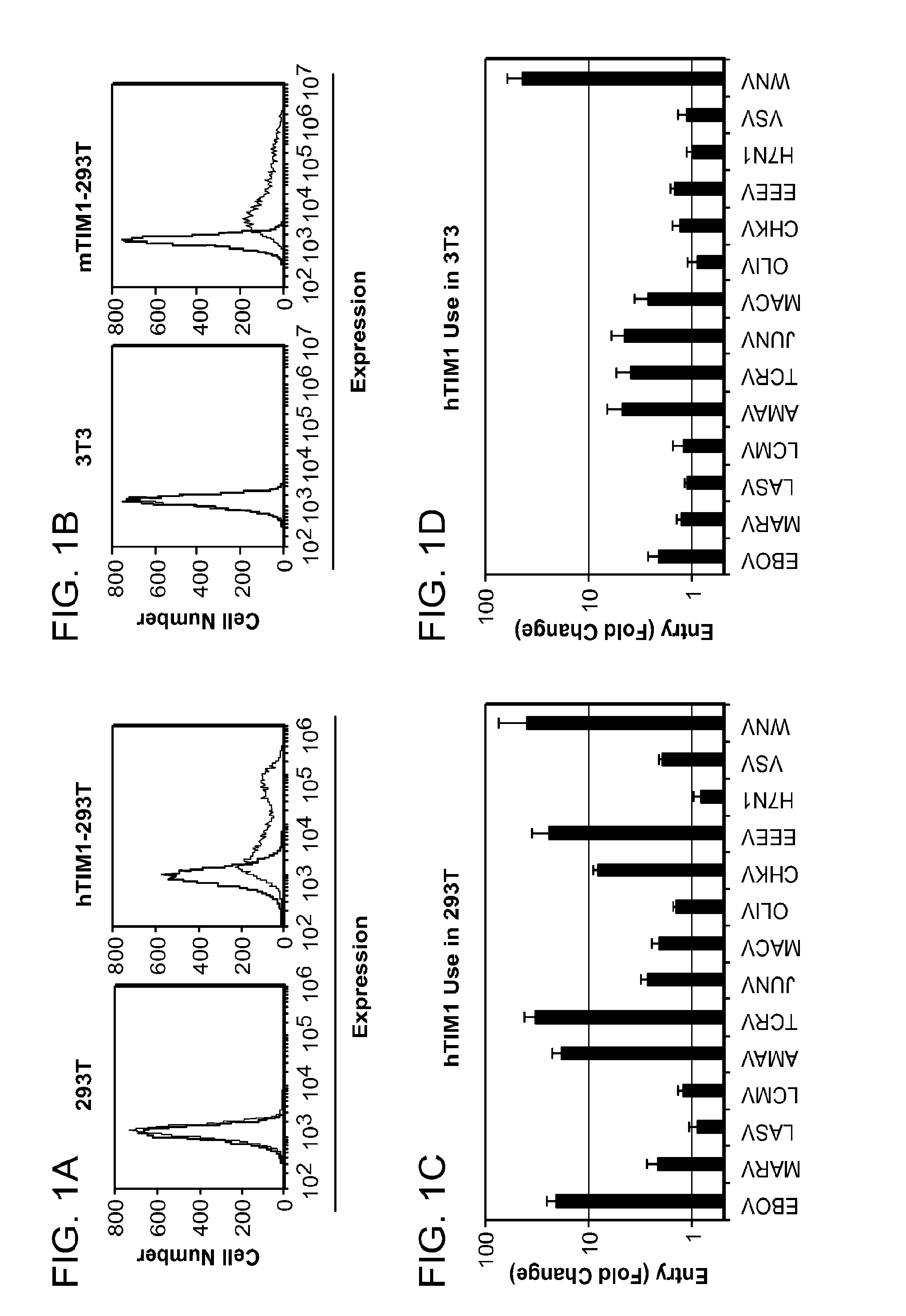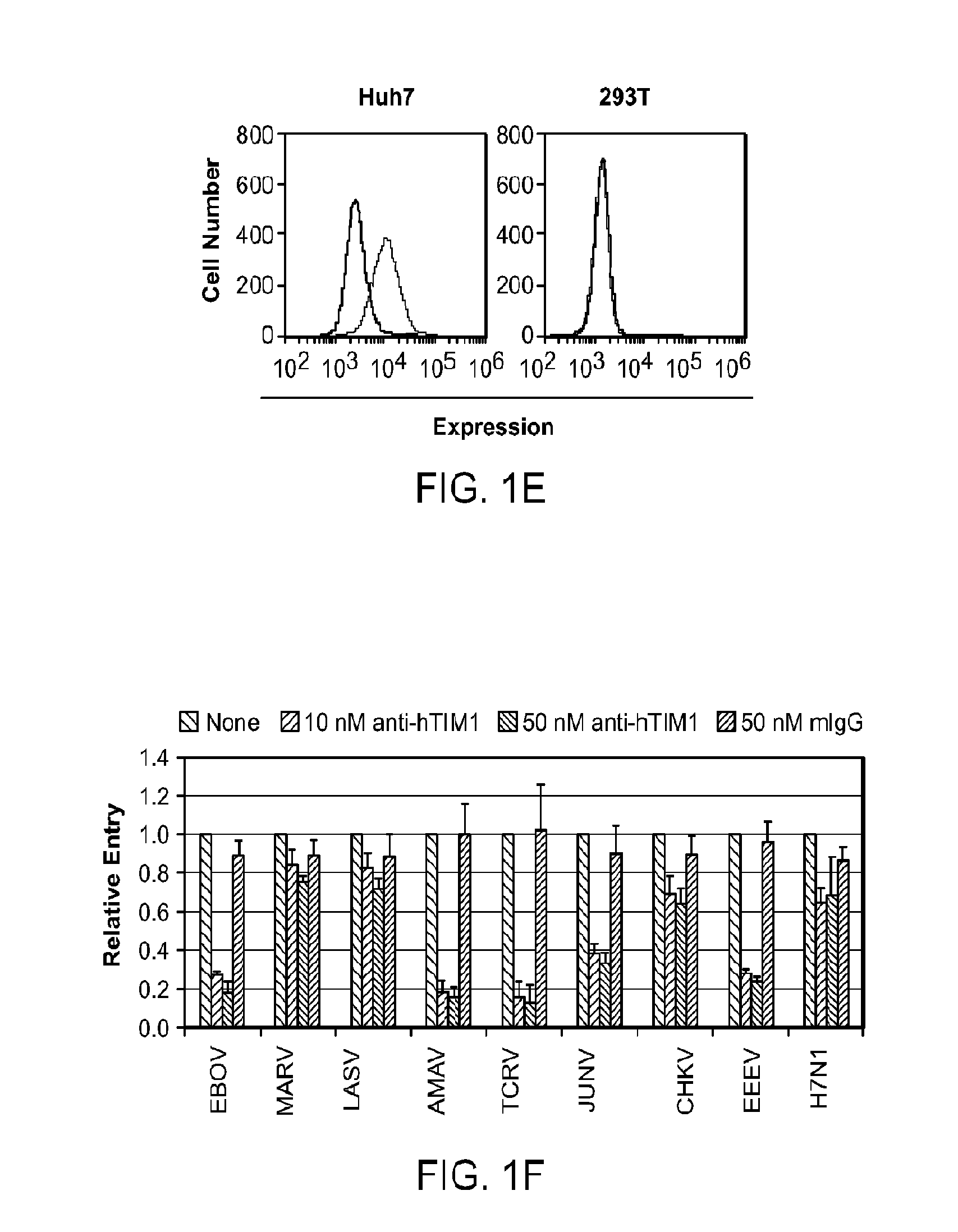Compositions and methods for inhibiting viral entry
a technology applied in the field of compositions and methods for inhibiting viral entry, can solve the problems of disease severity resulting from flavivirus infection, and serious public health problems, and achieve the effect of easy purification
- Summary
- Abstract
- Description
- Claims
- Application Information
AI Technical Summary
Benefits of technology
Problems solved by technology
Method used
Image
Examples
example 1
hTIM1 Promoted Pseudovirus and VLP Entry Mediated by a Range of Viral Entry Proteins
[0183]The specificity of viral use of hTIM1 was tested in two cell lines that express little or no endogenous TIMI: human 293T and murine 3T3 cells (FIGS. 1A and 1B). Cells engineered to overexpress hTIM1 or hACE2, a control receptor, were infected with a panel of 14 MLV pseudoviruses bearing the GPs of the filoviruses Ebola virus (EBOV) and Marburg virus (MARV), the arenaviruses Lassa virus (LASV), Lymphocytic choriomeningitis (LCMV), Amapari virus (AMAV), Tacaribe virus (TCRV), Junin virus (JUNV), Machupo virus (MACV) and Olifantsvlei (OLIV), the alphaviruses Chikungunya virus (CHKV) and Easter equine encephalitis virus (EEEV), the orthomyxovirus Influenza A (FLUAV) H7N1, the rhabdovirus Vesicular stomatitis virus (VSV) or the coronavirus Severe acute respiratory syndrome coronavirus (SARS-CoV). In addition, cells were infected with VLPs bearing the entry proteins of WNV, a member of the flavivirus...
example 2
hTIM1-Mediated Enhancement of Viral entry was PS Dependent
[0186]hTIM1 is a receptor involved in the PS-mediated uptake of apoptotic cells [21]. To test the hypothesis that hTIM1 may broadly increase viral entry because it binds 1,2-diacyl-sn-glycero-3-phospho-L-serine (PS) on viral membranes rather than to specific viral glycoproteins, viral usage of a hTIM1 variant defective in binding PS was compared with that of wt hTIM1. The mutant variant, hereafter referred to as AA-hTIM1, has two mutations in the PS-binding pocket that are known to nearly abrogate PS binding [19,21]. Indeed, when these receptors were overexpressed in 293T cells, AA-hTIM1 was unable to enhance the entry of any pseudovirus tested (FIG. 5A) despite efficient AA-hTIM1 expression (FIG. 5B). This indicates that viral hTIM1 usage is PS-dependent.
[0187]To further assess the role of PS, we tested whether various liposomes are able to block hTIM1-mediated viral entry (FIG. 5C). Consistent with a PS-dependent mechanism,...
example 3
TIM1-Mediated Virion Internalization was Independent of Viral Entry Proteins
[0188]PS dependency of viral hTIM1 usage indicated that virions lacking any viral entry protein should also bind to and internalize into the intracellular compartments of hTIM1-expressing cells. To test this hypothesis GFP-fused matrix proteins [45,46] were used that allow, when incorporated into the virions, the detection of prefusion stages of viral entry. As shown in FIGS. 7A and 7B, when 293T cells expressing hTIM1, AA-hTIM1 or a control receptor were infected with EBOV VP40-matrix-based VLPs (VP40-GFP VLPs), those bearing no GPs were readily internalized by hTIM1, provided that the TIM1 PS-binding domain was functional. Although EBOV GP-bearing VP40-GFP VLPs appeared to be internalized more efficiently than those lacking GP, this bias is most likely due to the fact that the latter are released 3 to 5 times less efficiently from the producer cells [50,51]. Consistent with this explanation, when the inter...
PUM
| Property | Measurement | Unit |
|---|---|---|
| Fraction | aaaaa | aaaaa |
| Fraction | aaaaa | aaaaa |
| Fraction | aaaaa | aaaaa |
Abstract
Description
Claims
Application Information
 Login to View More
Login to View More - R&D
- Intellectual Property
- Life Sciences
- Materials
- Tech Scout
- Unparalleled Data Quality
- Higher Quality Content
- 60% Fewer Hallucinations
Browse by: Latest US Patents, China's latest patents, Technical Efficacy Thesaurus, Application Domain, Technology Topic, Popular Technical Reports.
© 2025 PatSnap. All rights reserved.Legal|Privacy policy|Modern Slavery Act Transparency Statement|Sitemap|About US| Contact US: help@patsnap.com



